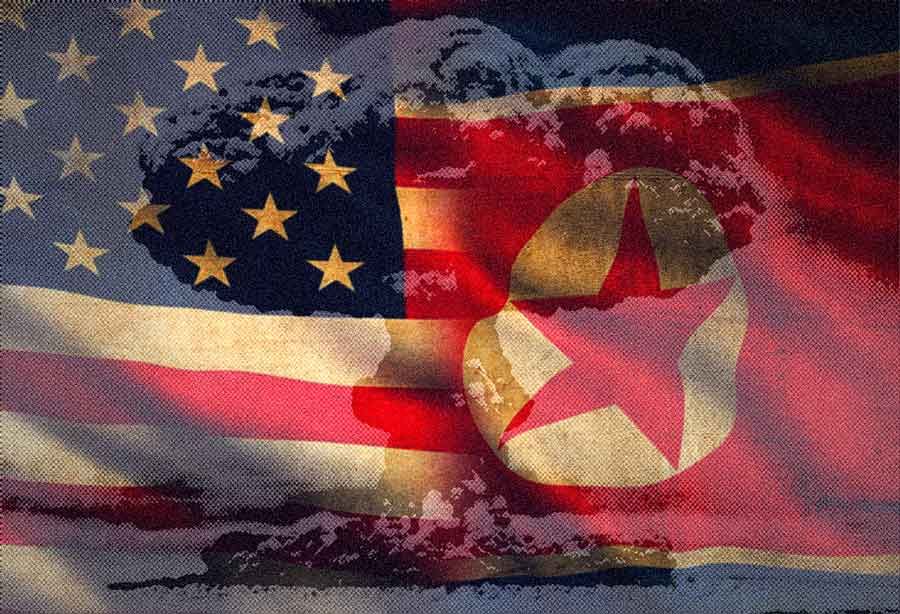Breaking the vicious cycle of the US-North Korea nuclear standoff
By Duyeon Kim | December 7, 2017
 North Korea Standoff
North Korea Standoff
North Korea’s ballistic missile test last week ended a nearly three-month lull in escalation between Pyongyang and Washington. During that period, US President Donald Trump visited South Korea as part of his Asian tour. As he so often does, he caused confusion and shock, but this time it wasn’t for the usual reasons. Trump had earlier insulted and threatened the North Korean leader on Twitter, bashed a US-South Korea trade pact, and accused South Korean President Moon Jae-in of preferring “appeasement” with the North, so South Koreans feared more bombastic comments about both Seoul and Pyongyang. Instead, Trump gave a moderate, gaffe-free, on-script speech to the South Korean National Assembly that suggested close alignment between his administration and Moon’s. Even a week later, after North Korean leader Kim Jong-un called Trump a “destroyer” and a “dotard,” Trump remained relatively measured in response—being Trump, he couldn’t resist a reference to Kim being “short” and “fat,” but he also said it was possible they could one day be friends.
Unfortunately, Trump’s surprising discipline and North Korea’s short pause in missile testing do not necessarily mean lowered tensions on the Korean peninsula. Instead, Pyongyang and Washington are caught in a vicious cycle of action and reaction. If nothing happens to break the cycle, it will continue until one side either stands down, which is very unlikely, or, far worse, takes military action. There is no reason to think North Korea will stop efforts to develop a nuclear weapon, a clearly stated national policy goal. Nor is there any reason to think the White House will stop imposing sanctions or threatening military action. Relations between Seoul and Washington, important to curbing the North Korean threat, could also be severely shaken. And neither Kim nor Trump have done much to reassure the world that they will act in a measured way to avoid a nuclear war by miscalculation or accident.
Yet we must prevent such a nuclear crisis. To do so, Washington, Seoul, Beijing and the international community must curb Pyongyang’s nuclear and missile development through diplomatic and economic pressure, while gearing up for negotiations for a diplomatic solution to all parties’ security concerns.
Trump plays nice, briefly. The US president’s November address was particularly well-received among South Koreans. Seoul got everything it wanted: balanced statements on policy, reassurance about the US-South Korean alliance, and promises for a brighter future. Even Washington’s harshest critics in Seoul gave his address positive ratings, much to their own surprise. National Assemblyman Ha Tae-kyung went so far as calling for the speech to be made required school reading (link in Korean).
Five US presidents had previously addressed South Korea’s national assembly, but none had done so in 24 years, since Bill Clinton visited in 1993. All of those earlier speeches addressed similar themes: Praise for South Korea’s “Miracle on the Han River,” the period of rapid economic growth following the Korean War; reaffirmation of the strong alliance between the United States and South Korea; and warnings to tyrannical North Korea. In allowing American presidents to boast of the alliance and praise the vibrantly democratic South, these addresses have been opportunities to send a message to a global audience, including North Korea.
Trump’s speech followed these past themes and served its traditional purpose. It painted a stark contrast between a free and prosperous South Korea and a dark, oppressed, and uncivilized North with detailed facts and statistics rather than rhetorical flourishes. Trump’s Tale of Two Koreas was apparently intended to justify his administration’s North Korea policy—which so far has consisted of maximum pressure on Pyongyang and diplomatic efforts to elicit Beijing’s cooperation—and make it morally difficult for anyone to harshly criticize his approach. The speech also seemed to be a message to the world—especially to China, Russia, and both Koreas—encouraging them to join in Washington’s tough stance. Trump called for complete isolation and containment as a way to change Pyongyang’s calculus and bring it to the negotiating table.
Trump also emphasized Washington’s goal of complete denuclearization of the Korean Peninsula, offered Kim a diplomatic exit ramp with “a path to a much better future” in return for denuclearization, and reaffirmed his country’s security commitment to South Korea. He further promised in his post-summit joint press conference that “there will be no skipping South Korea” in US decision-making about the North. These messages brought great relief to South Koreans, who were anxious the United States might broker a deal about the Korean Peninsula’s fate with China alone, as it did during the 1950-1953 Korean War, or take unilateral military action to deal with the North that would pull Seoul, Pyongyang, and Beijing into another devastating war.
Too soon, though, Trump’s brief restraint reverted to stick-wielding, when shortly after his return from Asia, he announced plans to designate North Korea a state sponsor of terrorism. Reinstating this designation is a symbolic, political tool that makes it taboo for other countries to interact with the regime. It would have been wiser from Trump to have waited until after Pyongyang’s inevitable next nuclear or missile test, because coming as it did after several months of quiet, the announcement just gave the regime another excuse to provoke.
Looking over the horizon. At the moment, the risk of unintentional nuclear conflict between North Korea and the United States—sparked by accident or misunderstanding—is higher than it ever been, as is the chance of a potential rift occurring between Washington and Seoul.
First, North Korea has every incentive to continue nuclear and missile testing to meet its national objective of acquiring a credible, reliable nuclear deterrent. This will eventually test the patience of Trump, Moon, and their countries’ alliance. Trump might revert back to his usual bombastic bluster that fuels escalation. More North Korean testing could further tempt White House advisors to choose military action, in line with the “peace through strength” Trump said he desired during his speech to the South Korean national assembly. Moon might find himself needing to say “no” to Trump, as he pledged he would during his recent presidential campaign, if Washington’s policy runs against South Korean interests. Seoul already announced, in late October, that it would oppose any new deployments of the US missile defense system known as THAAD (for Terminal High Altitude Area Defense) on its territory, and that it would not participate in a US-led missile defense system or a trilateral military alliance with the United States and Japan. This announcement added to suspicions in Washington about Seoul’s loyalty and intentions.
Second, Washington could still “skip South Korea” on North Korea policy despite Trump’s promise not to, if the two presidents do not build enough trust and engage in honest communication about their respective intentions and goals. Or, Seoul might (in Washington’s view) advance too far, too quickly in engaging Pyongyang, for instance by initiating an early inter-Korean summit, motivated by Moon’s desire to leave a legacy of reconciliation. Seoul and Washington could fall out in other ways, too, for example if Trump strong-arms South Korea into an unfair new trade deal, or takes unilateral military action that pulls Seoul into war. Such a rift could make it harder to rein in Pyongyang, giving it a gap to exploit that could raise prospects for regional chaos.
Finally, fissures between Washington, Seoul, and Beijing may emerge when Pyongyang decides to engage in dialogue, whether it does so as part of a tactical charm offensive or—the more likely scenario—because the regime has achieved its technological goals and is ready to engage in serious negotiations. At this point, the united front that Washington, Seoul, and Beijing are trying to display could unravel because of their fundamentally divergent approaches to the North Korean nuclear problem. Pyongyang’s negotiating game plan could then be to keep its reliable nuclear-tipped intercontinental ballistic missiles, while forgoing new weapons developments and seeking a range of political and security concessions.
What to expect, what to do. With Pyongyang continuing to achieve technological milestones in its nuclear and missile capabilities, and to threaten South Korea, Japan, and the United States with its arsenal, Washington will seek to impose sanctions even tougher than those that currently exist in order to further isolate and contain the country. Current and planned sanctions are aimed at pressuring Pyongyang back to the negotiating table and avoiding the military option. It is important, though, to let future sanctions speak for themselves, and not vilify or demonize North Korea in the process. Such rhetoric could make it politically difficult or even impossible to negotiate with Pyongyang if and when an opening is detected. Sanctions alone will not solve the North Korean nuclear problem—diplomatic negotiations with the regime are necessary too.
With this in mind, it would be wise for the United States and South Korea to begin discussing the potential components of a future negotiated deal. The first step should be for North Korea to verifiably halt its nuclear and missile programs, including all testing, and commit to eventual complete denuclearization in return for an American concession to Pyongyang. That concession could be either a modification of US-South Korean joint military drills to less inflammatory levels, or a pause in implementing future sanctions. As Pyongyang would still be able to threaten and attack US allies with its existing arsenal, Washington would also need to enhance its deterrence capabilities and tangibly reassure South Korea of its security commitment throughout the duration of any North Korean “freeze.”
The best way for Washington and Pyongyang to gauge whether they can achieve their desired outcomes through negotiations is to refrain from negotiating via the media and public pronouncements, and instead meet face-to-face. The challenge is to incentivize Pyongyang to return to dialogue soon and create a political environment in which the two sides can talk. The Trump administration has said it is open to striking a deal. Leaders from Washington to Seoul to Pyongyang and beyond must seize moments of opportunity to pursue a negotiated solution. The goal should be North Korea’s complete denuclearization, even though that will not happen quickly. Otherwise we will have to live with a nuclear North Korea, which will unravel international security.
Together, we make the world safer.
The Bulletin elevates expert voices above the noise. But as an independent nonprofit organization, our operations depend on the support of readers like you. Help us continue to deliver quality journalism that holds leaders accountable. Your support of our work at any level is important. In return, we promise our coverage will be understandable, influential, vigilant, solution-oriented, and fair-minded. Together we can make a difference.
Topics: Columnists, Nuclear Weapons














